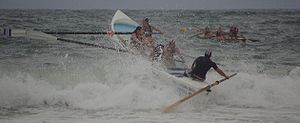
Long boat rescue
Encyclopedia


Positions
The positions in the boat are as follows:Bow (1) - the position nearest the bow (front) of the boat. Often regarded as the most dangerous of the positions.
Second Bow (2) - the next nearest the bow, their oar is on the opposite side to the bow rower's and these two rowers comprise the bow pair.
Second Stroke (3) - the next seat away from the bow and probably the seat closest to the centre of the boat, their main role is to stabilise the boat. Their oar is on the same side of the boat as the bow rower.
Stroke (4) - the seat closest to the stern (back) of the boat and the rower responsible for setting the speed and timing of the crew's rowing stroke. They combine with Second Stroke to make up the stern pair and their oar is on the same side as that of Second Bow.
Sweep - the person (usually man) in charge of steering the boat and, as they're the only one who can see what's ahead, they generally call the shots on the water. They also frequently double as the crew's coach.

